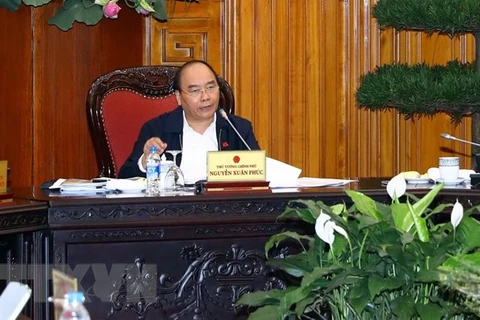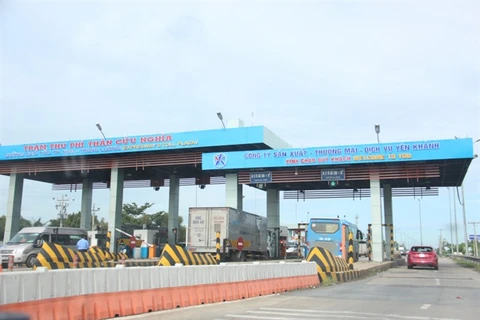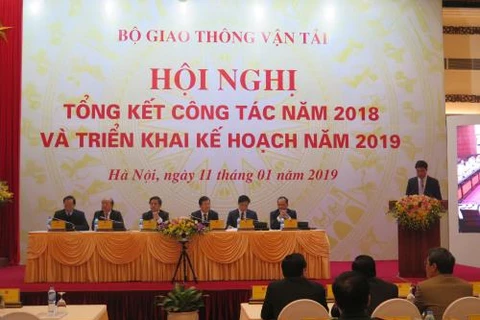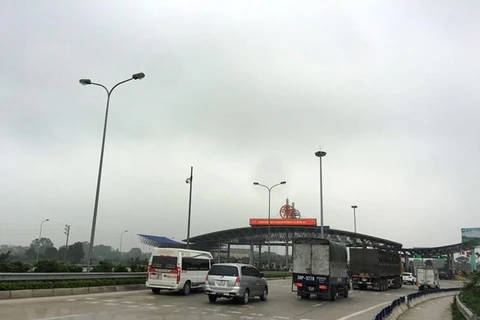Hanoi (VNS/VNA) - The Directorate for Roads of Vietnam (DRVN) is planning an investigation into toll collection activities of the State-run Vietnam Expressway Corporation (VEC) on all highways over concerns of a lack of transparency.
This comes after armed robbers escaped with almost 100,000 USD during a toll-station raid last week
Questions were raised over the amount of money stolen at the station on the busy Ho Chi Minh City-Long Thanh-Dau Giay expressway in southern Vietnam on the morning of February 7, the third day of the Lunar New Year.
Police said the two thieves made off with 2.2 billion VND (94,500 USD) in cash, which was reportedly the cash collected that morning alone, much higher than previous VEC’s report that the daily revenue reached no more than 1 billion VND (42,900 USD).
A VEC representative explained that as per the arrangements with its bank partner, the bank representative would arrive at the stations to pick up the toll once a day, but during the holiday, the toll pickup is every two days, resulting in the high amount of cash on the premises.
Mai Tuan Anh, Chairman of VEC, told the media that speculation of the corporation’s underreporting revenues is totally unfounded.
The largest highway operator in Vietnam also said it has in place several measures – including the use of 24/7 security cameras and internal audits – to ensure secure and accurate management of toll collection.
“All the tolls collected along the highways we manage would be transferred into the State budget, the collection process as well as the corporation’s expenditure are all closely monitored by the Directorate for Roads of Vietnam,” Anh said, adding that VEC is working with the police to verify the revenues and put to rest “unnecessary rumours”.
VEC said the toll collecting units need to send a report detailing the total traffic and revenue to the corporation on a daily and monthly basis, and VEC itself would submit reports to the DRVN and the transport ministry each quarter.
DRVN General Director Nguyen Van Huyen told Voice of Vietnam (VOV) the directorate would start inspecting the toll collection process by VEC after the police finished their investigation into alleged wrongdoings at the southern expressway.
Huyen agreed with VEC that the toll collection protocols at the corporation are quite “stringent and transparent”.
All four of highways under VEC’s management – Cau Gie-Ninh Binh and Noi Bai-Lao Cai in the north, Da Nang-Quang Ngai in the central region, and HCM City-Long Thanh-Dau Giay in the south – are built with official development assistance (ODA) capital, however, the roads are still tolled to recover loans and investment capital, drawing similarities to the Build-Operate-Transfer (BOT) model which also came under scrutiny in recent times for lack of transparency.
Given the recent State budget constraints, many infrastructure projects across Vietnam were funded by private investors via concession models like BOT.
Previously, five people – including the director and deputy director – of the Yen Khanh Company, which collects tolls at the BOT station on the high-traffic six-lane HCM City-Trung Luong expressway, were arrested for manipulating software to falsify revenue and evade tax.
The case once again raised the issue of the need to have all BOT toll plazas fitted with electronic toll collection (ETC) systems to boost transparency and allow for fast, convenient transactions by eliminating the need for human staff or the use of cash.
To Nam Toan, head of the science-technology and international cooperation department under the DRVN, said the deployment of the ETC system began in July 2017, but it’s unlikely the transport ministry’s target of having all BOT lanes equipped with ETC by the end of 2019 would be met.
But, he said, all BOT stations will have at least one or two ETCs.
Toan said the reason for the delay could be that the BOT investors are still not willing to be transparent with their revenues or trust a third-party ETC service provider with collecting the toll.
He said the DRVN is building a circular detailing the regulations on non-stop toll collection and institutionalising penalties against BOT investors or drivers who fail to follow regulations on ETC.
Toan expects that by the end of 2019, the State Bank of Vietnam would finish developing a payment portal to facilitate toll payments.-VNS/VNA
This comes after armed robbers escaped with almost 100,000 USD during a toll-station raid last week
Questions were raised over the amount of money stolen at the station on the busy Ho Chi Minh City-Long Thanh-Dau Giay expressway in southern Vietnam on the morning of February 7, the third day of the Lunar New Year.
Police said the two thieves made off with 2.2 billion VND (94,500 USD) in cash, which was reportedly the cash collected that morning alone, much higher than previous VEC’s report that the daily revenue reached no more than 1 billion VND (42,900 USD).
A VEC representative explained that as per the arrangements with its bank partner, the bank representative would arrive at the stations to pick up the toll once a day, but during the holiday, the toll pickup is every two days, resulting in the high amount of cash on the premises.
Mai Tuan Anh, Chairman of VEC, told the media that speculation of the corporation’s underreporting revenues is totally unfounded.
The largest highway operator in Vietnam also said it has in place several measures – including the use of 24/7 security cameras and internal audits – to ensure secure and accurate management of toll collection.
“All the tolls collected along the highways we manage would be transferred into the State budget, the collection process as well as the corporation’s expenditure are all closely monitored by the Directorate for Roads of Vietnam,” Anh said, adding that VEC is working with the police to verify the revenues and put to rest “unnecessary rumours”.
VEC said the toll collecting units need to send a report detailing the total traffic and revenue to the corporation on a daily and monthly basis, and VEC itself would submit reports to the DRVN and the transport ministry each quarter.
DRVN General Director Nguyen Van Huyen told Voice of Vietnam (VOV) the directorate would start inspecting the toll collection process by VEC after the police finished their investigation into alleged wrongdoings at the southern expressway.
Huyen agreed with VEC that the toll collection protocols at the corporation are quite “stringent and transparent”.
All four of highways under VEC’s management – Cau Gie-Ninh Binh and Noi Bai-Lao Cai in the north, Da Nang-Quang Ngai in the central region, and HCM City-Long Thanh-Dau Giay in the south – are built with official development assistance (ODA) capital, however, the roads are still tolled to recover loans and investment capital, drawing similarities to the Build-Operate-Transfer (BOT) model which also came under scrutiny in recent times for lack of transparency.
Given the recent State budget constraints, many infrastructure projects across Vietnam were funded by private investors via concession models like BOT.
Previously, five people – including the director and deputy director – of the Yen Khanh Company, which collects tolls at the BOT station on the high-traffic six-lane HCM City-Trung Luong expressway, were arrested for manipulating software to falsify revenue and evade tax.
The case once again raised the issue of the need to have all BOT toll plazas fitted with electronic toll collection (ETC) systems to boost transparency and allow for fast, convenient transactions by eliminating the need for human staff or the use of cash.
To Nam Toan, head of the science-technology and international cooperation department under the DRVN, said the deployment of the ETC system began in July 2017, but it’s unlikely the transport ministry’s target of having all BOT lanes equipped with ETC by the end of 2019 would be met.
But, he said, all BOT stations will have at least one or two ETCs.
Toan said the reason for the delay could be that the BOT investors are still not willing to be transparent with their revenues or trust a third-party ETC service provider with collecting the toll.
He said the DRVN is building a circular detailing the regulations on non-stop toll collection and institutionalising penalties against BOT investors or drivers who fail to follow regulations on ETC.
Toan expects that by the end of 2019, the State Bank of Vietnam would finish developing a payment portal to facilitate toll payments.-VNS/VNA
VNA
























